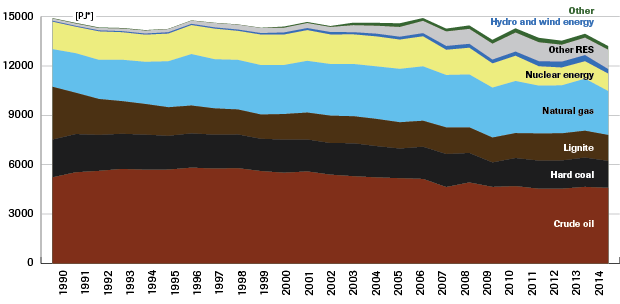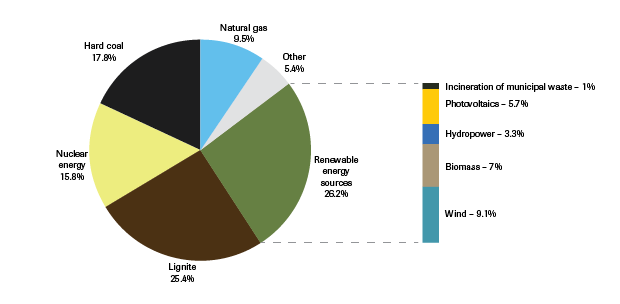The uncertain future of the coal energy industry in Germany
Germany’s current energy strategy, known as the “energy transition”, or Energiewende, involves an accelerated withdrawal from the use of nuclear power plants and the development of renewable energy sources (RES). According to the government’s plans, the share of RES in electricity production will gradually increase from its present rate of 26% to 80% in 2050. Greenhouse gas emissions are expected to fall by 80–95% by 2050 when compared to 1990 levels. However, coal power plants still predominate in Germany’s energy mix – they produced 44% of electricity in 2014 (26% from lignite and 18% from hard coal). This makes it difficult to meet the emission reduction objectives, lignite combustion causes the highest levels of greenhouse gas emissions. In order to reach the emission reduction goals, the government launched the process of accelerating the reduction of coal consumption. On 2 July, the Federal Ministry for Economic Affairs and Energy published a plan to reform the German energy market which will be implemented during the present term of government. Emission reduction from coal power plants is the most important issue. This problem has been extensively discussed over the past year and has transformed into a conflict between the government and the coal lobby. The dispute reached its peak when lignite miners took to the streets in Berlin. As the government admits, in order to reach the long-term emission reduction objectives, it is necessary to completely liquidate the coal energy industry in Germany. This is expected to take place within 25 to 30 years. However, since the decision to decommission nuclear power plants was passed, the German ecological movement and the Green Party have shifted their attention to coal power plants, demanding that these be decommissioned by 2030 at the latest.
The problem with reducing greenhouse gas emissions by 2020
Climate policy is the source of the internal German conflict over lignite. Germany is among those countries (along with e.g. the United Kingdom, France and the countries of Scandinavia) which are most strongly engaged in the global reduction of greenhouse gases. In 2007, Berlin unilaterally adopted the goal to reduce emissions by 40% by 2020, compared to 1990 levels[1]. However, carbon emissions were falling at a slower rate than expected, and even rose in 2011–2013. There were several reasons for this trend, the most important being increased power production by coal power plants after eight nuclear power plants were decommissioned following the Fukushima disaster. The decision to withdraw from the use of nuclear power plants coincided with the shale revolution in the USA, which led to a reduction in demand for coal and, consequently, falling gas prices on the global market. This led to an increased share of coal in electricity production in EU member states, including Germany. This trend coincided with the fall in prices of carbon allowances in the EU emission trade system resulting in increased production of energy from lignite in Germany. In effect, even though in 2010–2013 electricity consumption in Germany fell by 15% and electricity production using RES increased by 47%, energy production from coal also rose by 23% and thus contributed to higher carbon emissions. Hence the “Energy Transition Paradox” mentioned by German experts – even though energy production with the use of emission-free renewable sources has been developing at a rapid rate, carbon emission levels have been growing. Already in 2013, Peter Altmaier (CDU), who was then the minister for the Environment, said that Germany would not be able to reach the goal of reducing emissions by 40% by 2020. However, when the government changed, the Social Democrats became the new coalition partners for the Christian Democrats and forced the coalition to set the goal of a 40% emission reduction by 2020. SPD politicians were nominated Minister for Economic Affairs and Energy and Minister for the Environment. In December 2014, the government adopted the Action Programme on Climate Protection 2020[2]. The document specified a number of actions to be taken in order to reduce emissions in individual sectors, including the power production sector which accounts for 40% of greenhouse gas emissions in Germany. Carbon emissions are expected to have fallen to 749 million tonnes in Germany by 2020 (in 2013 they reached 951 million tonnes). According to most recent Eurostat data (for 2012), Germany is EU’s largest greenhouse gas emitter and accounts for 20.6% of all emissions. In this ranking, Germany is followed by the United Kingdom (13.1%), France (11%), Italy (10%) and Poland (8.6%). German emissions per capita are above the EU average level of 9 tonnes of CO2 equivalent per capita annually. As compared to Germany (11.4 tonnes), emissions are higher only in the Czech Republic (12.5 tonnes), Ireland (12.8 tonnes), Estonia (14.5 tonnes) and Luxembourg (22.6 tonnes)[3]. Poland (10.4 tonnes) has lower emissions per capita than Germany.
The dispute over the climate levy
On 27 March 2015, the Ministry for Economic Affairs and Energy led by Sigmar Gabriel (SPD) presented a plan for reforming the energy market with the proposal to impose a carbon emissions tax on coal power plants, the so-called ‘climate levy’ (German Klimaabgabe). According to the government’s proposal, a levy of 18–20 euros per tonne of CO2 would be imposed on old coal power plants in operation for more than 20 years. In the ministry’s opinion, this proposal would bring the following positive effects: it would eliminate the oldest coal power plants from the market and reduce power exports, since excessive electricity production has destabilised the market in Germany and neighbouring countries (in the past few years Germany sold the largest amount of electricity in its history)[4]. This proposal was received positively by organisations involved in the protection of environment, scientists, the RES lobby, and municipal companies.
Energy producers, trade unions and some politicians from the Christian Democratic and Social Democratic parties have reacted negatively to this proposal. It has been argued that the imposition of additional taxes on coal power plants will lead to job losses and the collapse of the lignite sector[5]. It has also been argued that power supplies could be interrupted if too many coal power plants discontinued operation within a timeframe of several years. Opponents of the tax on power plants could count on support from politicians. Their demands were backed by politicians from all parties, with the exception of the Greens. Politicians from the SPD (including the ministers-president of North Rhine-Westphalia and Brandenburg) and the CDU have been especially active. Lobbyists representing the coal energy sector, including Peter Terium, the CEO of RWE, Hildegard Müller, the head of the German Association of Energy and Water Industries (BDEW) and Stanislaw Tillich (CDU), the minister-president of Saxony, took part in the talks on the struggle to continue lignite production in North Rhine-Westphalia during a convention of CDU politicians from this federal state on 23 April. The coalition partners from the CDU/CSU also lobbied against Gabriel’s idea in parliament, where 14 MPs published an open letter to Chancellor Angela Merkel. There was also a demonstration by 15,000 trade union activists, who took to the streets on 25 April in Berlin to protest against the climate fee, which marked a breakthrough in this dispute.
Following the attack from the industry, the trade unions and CDU/CSU and SPD politicians, the Ministry for Economic Affairs and Energy led by Sigmar Gabriel (SPD) halted its efforts to impose the climate levy on coal power plants. A new proposal to reduce emissions from coal power plants was published on 2 July as a Political Agreement between the SPD, the CDU and the CSU on the Future of the Energy Transition[6]. According to the agreement, lignite power plants with a capacity of 2.7 GW (i.e. 13% of the capacity of German lignite power plants) will be classified as the so-called ‘emergency standby reserve’. This means that these power plants will only be put into operation in emergency situations, when the remaining power plants operating on the market are unable to cope with demand. The coal power plants classified as the power reserve will receive compensation for remaining on standby for four years, and will then be closed. The ministry’s new proposal will result in a reduction of carbon emissions by power plants – 11 million tonnes by 2020. The original plans envisaged a reduction in carbon emissions 22 million tonnes by 2020. The emission reduction goal as a whole is to be reached by increased energy saving and the construction of new combined heat and power plants. This solution will require additional budget subsidies on energy efficiency (around 1.2 billion euros annually), and on the development of combined heat and power plants (around 0.5 billion euros annually). Experts estimate that the costs of the so-called ‘power reserve’ for energy consumers will reach 0.5–1 billion euros annually[7].
The decision to pay power plant operators for remaining on standby has provoked radically different reactions. Some experts and ecological organisations have criticised the government for caving in to the coal lobby and for breaking their word. Opinions could be heard in the media that the image of Germany as a country engaged in an ambitious climate policy had been tarnished. In turn, chambers of industry and trade unions have expressed a positive opinion about this plan. According to the German Institute for Economic Research, the government’s energy policy is inefficient because clients will have to incur the additional costs of the ‘disability pension’ paid to coal power plants, and the risk will remain that the emission reduction target will not be achieved[8]. The government’s withdrawal from its plans needs to be viewed as a failure of the SPD’s energy and climate policy. The main argument raised by the opponents of the climate fee, i.e. the risk of bankruptcy of the lignite sector, has not been confirmed in the expert opinion from the Federal Environment Agency[9]. The fact that coal power plants have been classified as a power reserve needs to be viewed as an economic success of the CDU, which has from the very beginning protested against the proposal of the Ministry for Economic Affairs and Energy to impose the climate fee on the oldest coal power plants.
The place of coal in the German economy
Hard coal used to be the basis of the German economy. Up until the mid-1960s (see Appendix), the German energy sector, heating sector and railway transport heavily relied on hard coal and, to some extent, lignite. One proof that coal was so important is the fact that one of the main goals of the European Coal and Steel Community was to limit Germany’s advantage in European coal deposits. In 1956 (when coal consumption reached its peak in Germany), 86% of the energy used was produced from German coal, most of which was mined in the Ruhr region (71% from hard coal and 15% from lignite). Subsequently, hard coal mining began to fall back relatively rapidly, and coal’s share in energy production was nearly halved within the next twenty years. This happened for many reasons, the most important of which were: the depletion of easily accessible coal deposits in Germany, the introduction of substitute fuels to the market (crude oil, natural gas and nuclear energy), greater accessibility to imported coal and the environmental protection issue (during the combustion process coal emits more pollution than oil or gas). Between 1960 and 1970, the number of working miners fell from around 505,000 to around 242,000. Since hard coal production generated losses, subsidies for this sector were first introduced in 1974, and reached their highest level in 1996, when the federal and local budgets offered subsidies worth 8.27 billion euros to the coal sector, i.e. 97,000 euros per employee. The subsidy levels have been falling since then, and German hard coal mining is supported mainly for welfare reasons (retention of workplaces) and has nothing in common with energy security. In 1997, 2003 and 2007, the German government signed agreements with mining organisations envisaging a reduction of output and a gradual winding up of the mines. The most recent agreement provides that subsidies to hard coal mines will only be paid until the end of 2018, which has also been confirmed in the European Union’s regulation. At present, three German hard coal mines are still managed by RAG Deutsche Steinkohle AG. They employ around 9,800 people.
In 2014, hard coal accounted for 12.6% of primary energy consumption, and lignite for 12%. Coal is thus the most important fuel in the German economy after oil (35%). While almost 90% of hard coal is imported, all of Germany’s lignite demand is satisfied by domestic producers. In 2013, hard coal output reached around 7.5 million tonnes, which accounted for around 12% of domestic consumption. The largest suppliers of hard coal in 2013 included Russia (12.5 million tonnes), the USA (12 million tonnes) and Columbia (10 million tonnes); imports from Poland reached 3.4 million tonnes. 70% of hard coal is burnt at power plants and combined heat and power plants, 28% is used as part of industrial processes and 2% for individual needs. In turn, 90% of lignite is used by power plants, and the remaining 10% as part of industrial processes. Unlike with hard coal, lignite reserves in Germany are still high, and the industry is not subsidised. In 2013, Germany was the world’s largest lignite consumer, with an annual output of 183 million tonnes, followed by China (147 million tonnes), Russia (73 million tonnes) and the USA (68.8 million tonnes). Estimated German lignite reserves stand at 35.1 billion tonnes. Lignite is produced in four mining regions:
- the Rhenish lignite mining region in North Rhine-Westphalia (53% of Germany’s output in 2013), managed by Germany’s RWE;
- the Lausitz lignite mining region n Brandenburg (35% of Germany’s output in 2013), managed by Sweden’s Vattenfall;
- Central German lignite mining region in Saxony (11% of Germany’s output in 2013), managed by the Czech company EP Energy;
- the Helmstedt lignite mining region on the border between Saxony-Anhalt and Saxony (1% of Germany’s output in 2013), managed by the Czech company EP Energy.
Around 16,400 people are engaged in lignite mining, and around 70,000 (including co-operators) are employed in the lignite industry as a whole. This fuel has a number of economic, political and technical advantages. Energy from lignite is cheap, and lignite power plants are used as base load power plants in the power supply system, i.e. they work uninterruptedly with fixed performance levels and are responsible for the stability of the power supply system. Furthermore, lignite is a domestic resource, and its production guarantees employment to many residents of Germany. Nevertheless, the use of lignite in Germany is a controversial issue. The main argument against lignite extraction is the impact it has on the environment – lignite causes the highest levels of emissions of all available fuels and, furthermore, its production also causes deteriorating air quality, soil degradation, the reduction of crops, etc. Another argument against further use of lignite is the impact it has on society – if RWE’s and Vattenfall’s plans to develop the queries are implemented, this will mean that around 10,000 people will be forced to relocate, and their homeland and material legacy will be irretrievably lost.
As proven by the dispute over taxes on coal power plants, the political parties have no clear stance on the coal energy sector. At present, the CDU as a party which claims to have high economic competences is more willing to back the demands of the lignite sector. The German Green party in turn is clearly opposed to further use of lignite. The stances of the SPD and the Left Party (die Linke) are unclear. On the one hand, the left-leaning politicians support the ambitious climate policy and the decarbonisation of the economy on the rhetorical level. On the other hand, local politicians from the SPD and the Left Party protect the interests of the coal industry in the regions they represent.
The dim long-term perspective for coal in Germany
The overriding goal of all actions taken by the German government in the area of energy policy is to implement the energy transition. This strategy envisages that 80% of electricity will be produced using renewable energy sources in 2050. Carbon emissions will be cut by at least 80% in 35 years, but the left of the political scene demands that the goal should be to reduce them by 95% of 1990 levels. Climate policy goals of this type do not leave much room for the coal energy sector, and in particular, for lignite, which is the source of the highest levels of emissions. The power supply system based on renewables will be supported by gas power plants, which will be able to use biogas or syngas in the future. Furthermore, Germany stands for a decarbonisation of the economy and the reduction of global greenhouse gas emissions on the international forum. During the G7 summit in Elmau, Germany in June 2015, German representatives signed the Group’s declaration concerning the complete decarbonisation (reduction of carbon emissions to zero) by the end of this century. The Minister for the Environment, Barbara Hendricks (SPD), has emphasised that to reach the long-term climate policy objectives, the coal energy sector (this concerns both hard coal and lignite) must discontinue its operation in Germany by 2040–2045[10]. In the medium term, the energy sector based on lignite will most likely no longer be profitable in Germany. It may be concluded from an analysis developed by the German Institute for Economic Research (DIW) that building new lignite power plants and new lignite mines is not economically viable. This has also been noticed by energy companies. Sweden’s Vattenfall has announced that it wants to sell its lignite power plants and mines in Germany by the end of 2015. It is unclear whether RWE’s project envisaging the construction of a new lignite power plant, known as BoAplus, in North Rhine-Westphalia will be implemented, since the future of this kind of investment is uncertain. Another factor which raises the level of risk in the case of coal investments is the negative perception of coal prevalent among the public. Both the Green Party and German ecological organisations insist that the coal energy sector needs to be dismantled by 2030. The ‘coal phase-out’ (German Kohleausstieg) may become as popular a political slogan in the future as was the ‘nuclear power phase-out’ (Atomausstieg, in German). According to a poll conducted in February 2015, 19% of Germans want all coal power plants to be closed soon, and 48% want a coal phase-out in the medium term. However, as proven by the conflict over the climate fee on coal power plants, there is a strong lignite lobby in Germany, and they are determined to protect their present assets.
Appendix
Primary energy consumption in West Germany in 1950-1990 in million tonnes of hard coal equivalent (German Steinkohleeinheit)

Source: AG Energiebilanzen e.V.
Primary energy consumption in East Germany in 1957-1990 in million tonnes of hard coal equivalent (German Steinkohleeinheit)

Source: AG Energiebilanzen e.V.
Primary energy consumption in Germany in 1990-2014 in petajoules (PJ)

Source: Federal Ministry for Economic Affairs and Energy
Gross electricity production in Germany in 2014

Source: German Association of Energy and Water Industries (BDEW)
[1] Klimaagenda 2020: Der Umbau der Industriegesellschaft, April 2007, http://www.bmub.bund.de/fileadmin/bmu-import/files/pdfs/allgemein/application/pdf/hintergrund_klimaagenda.pdf
[2] Rafał Bajczuk, ‘Niemieckie problemy z redukcją emisji CO2’ OSW Commentary, 16 December 2014, http://www.osw.waw.pl/pl/publikacje/komentarze-osw/2014-12-16/niemieckie-problemy-z-redukcja-emisji-co2
[3] Eurostat, http://ec.europa.eu/eurostat/statistics-explained/index.php/Greenhouse_gas_emission_statistics#Main_tables
[4] See Agora Energiewende, Neuer Rekord beim Stromexport, 17 July 2015, http://www.agora-energiewende.de/de/presse/agoranews/news-detail/news/1-neuer-rekord-beim-stromexport/News/detail/
[5] The trade unions claimed that 100,000 people could lose their jobs. The press release from the Federal Lignite Association of 15 April 2015 states that the coal tax may lead to the liquidation of 40,000 jobs in the lignite sector; http://www.presseportal.de/pm/9341/2997191
[6] Eckpunkte für eine erfolgreiche Umsetzung der Energiewende Politische Vereinbarungen der Parteivorsitzenden von CDU, CSU und SPD vom 1. Juli 2015, http://www.bmwi.de/BMWi/Redaktion/PDF/E/eckpunkte-energiewende,property=pdf,bereich=bmwi2012,sprache=de,rwb=true.pdf
[7] Teurer Klimaschutz mit Kapazitätsreserve, Forum Ökologisch-Soziale Marktwirtschaft, June 2015, p. 5, https://www.greenpeace.de/sites/www.greenpeace.de/files/publications/teurer_klimaschutz_mit_kapazitatsreserve_201506.pdf
[8] A press release from the German Institute for Economic Research on 24 June 2015: Klimabeitrag kann CO2-Emissionen im Stromsektor effektiv und kostengünstig senken – Alternative Vorschläge ineffektiv und teuer http://www.diw.de/de/diw_01.c.509353.de/themen_nachrichten/klimabeitrag_kann_co2_emissionen_im_stromsektor_effektiv_und_kostenguenstig_senken_alternative_vorschlaege_ineffektiv_und_teuer.html
[9] Klimabeitrag: Jobverluste in der Braunkohle kaum zu befürchten, 24 May 2015, http://www.umweltbundesamt.de/themen/klimabeitrag-jobverluste-in-der-braunkohle-kaum-zu
[10] Interview with Barbara Hendricks (SPD) for Die Zeit, ‘Wir müssen in den nächsten 25 bis 30 Jahren aussteigen’, 26 June 2015, http://www.zeit.de/2015/28/barbara-hendricks-kohle-energie-atommuell





